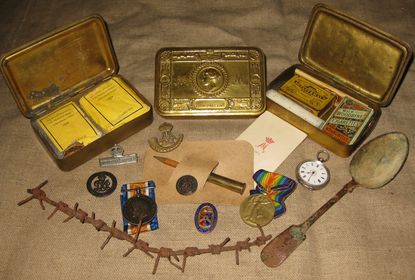Today we take a trip back to Christmases past with Milestones Museum Volunteer David P. Whithorn, as he discusses some very special festive items from his personal collection.

When war broke out in August 1914, many young men rushed to enlist to ‘do their bit’. Most people at the time believed the war would be over by Christmas. Yet for those young people, there would be five such Christmases before the lucky ones would finally return home.
In October 1914, 17 year-old, Princess Mary (daughter King George V and Queen Mary), helped to initiate the ‘Soldiers and Sailors Christmas Fund,’ aiming to send every soldier at the front and sailor at sea a Christmas present. This would be in the form of a well-made brass box, embossed with ‘Christmas 1914’ and the names of all the Allies, as well as the effigy of Princess Mary and her monogram ‘M’.
These would be distributed to all British and Empire soldiers and sailors. The tin would be sized to fit comfortably in a serviceman’s pocket, but the contents could be tuned to match any cultural differences. All the boxes would contain a card and a photograph of the Royal family. However, the gift itself would vary. The majority would contain a packet of cigarettes (also monogrammed ‘M’) and pipe tobacco. A pipe or cigarette lighter would be supplied separately. For those not wishing tobacco, there was a ‘bullet-pencil’ secured in a card, topped with sweets or chocolate.
These gifts to the troops proved immensely popular and, due to supply delivery constraints, were still being supplied at the end of the war. Many tins were sent home to loved ones, unopened, as souvenirs. Most, after their contents had been consumed, provided ‘crush-proof’ storage for precious items (cigarettes etc.) through the war.
There were instances of large scale truces between British and German forces across No-Man’s land that Christmas in 1914, even reports of football matches being played and exchanges of gifts. Such informalities would not be tolerated again on such a scale. At later Christmases, any such truces would be kept quiet, very small scale and localised. Planned artillery bombardments, by both sides, over Christmas put paid to any further enthusiasm for ‘fraternisation with the enemy’.
Generally, troops ‘had their Christmas’ behind the lines, when relieved from the trenches. Every effort would be made to celebrate, with food and drink bought both locally and from home. Officers would traditionally wait upon their men. Leave to England would be granted where possible for officers and men, subject to requirements in the line.

This photograph shows three such ‘Mary tins’ as they were called by the troops. One still has its tobacco and one still its card with the ‘bullet-pencil’ – truly rare items! The third is filled with the items a soldier would need to hand, cigarettes, matches, a candle, pencils and a small comb for his moustache!
Two of these tins have special stories...
I was given the tin with the original tobacco products by a Basingstoke man, Jim. Originally this had been given to his father, serving in India in 1914. As a boy, Jim had been caught playing with it (trying to extract cigarettes!) by his father, who was furious. After Jim had given it to me, I very carefully emptied the tin to try and replace the original cigarettes back into the packet as best I could. Under the packets was a carefully tied lock of long black hair. The next time I saw Jim, I asked what colour his mother’s hair had been. ‘Sort of light brown’, he told me quizzically. I did not enlighten him and the lock of hair is still there, hidden – maybe Jim’s father had not been angry about the cigarettes...
The tin with the ‘assorted contents’, I had found at a church bazaar, again in Basingstoke. Dirty, battered and a little crushed it was on a table, unpriced. As I looked at it, I asked the man behind the stall if it was for sale. ‘Yes, everything is £1!’ he beamed. ‘What!!!, that is a pound???’, I could not help replying in a “surprised” tone. Crestfallen, the man said, ‘Is that too much?’. Collecting myself and in a much calmer voice, I said, ‘You do not know what this is do you? As this is a church, and the money is going to a good cause, I am going to give you a bit more than you were asking...’ Unlike the other ‘pristine’ tins, this one is a little battered and crushed from living in a soldier’s tunic pocket – it was there for him to keep his treasured items in for the time he was in the trenches. These, I have ‘replaced’, and the tin now lives in my tunic pocket – it is never cleaned, but once again has been ‘polished’ on the edges simply through handling and use – all exactly as it once was...
A World War I Tommy’s Christmas present indeed! In the photograph are other objects from the Great War, these items would have been familiar to the Tommies in the trenches, one or two are VERY special indeed. How many do you recognise?




